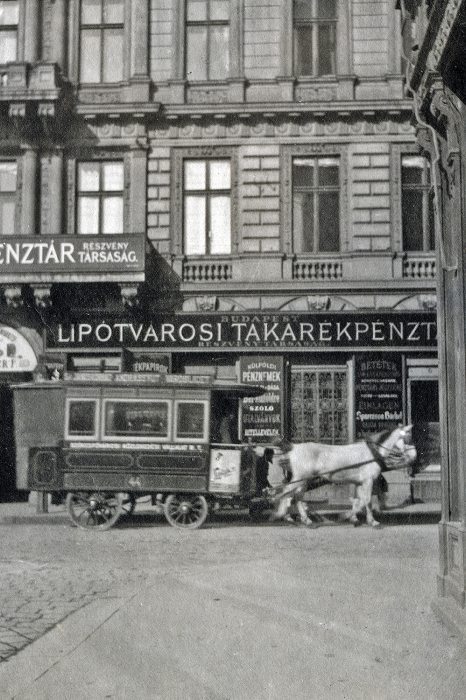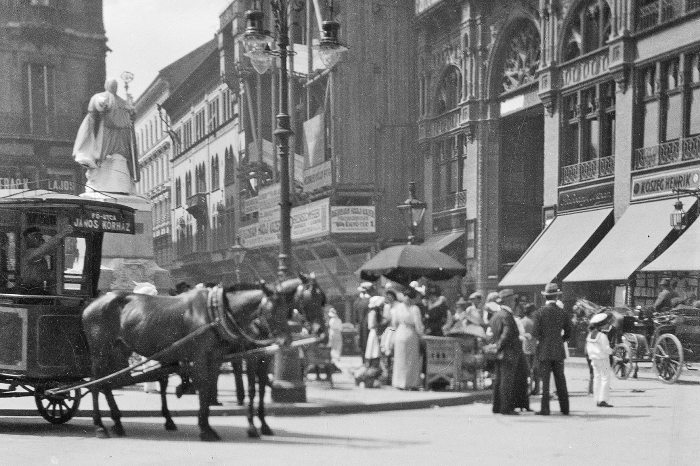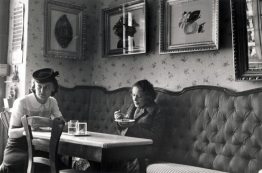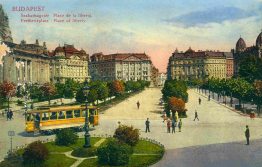Let's bump back to the era of the omnibus!
The omnibus, once even sung about in an operetta hit, was one of the most popular means of urban transport in the 19th century. The ancestor of the car and trolleybus, the omnibus was drawn by horsepower and made travel accessible to the masses in the ever-growing Pest-Buda as well as in the rural cities.
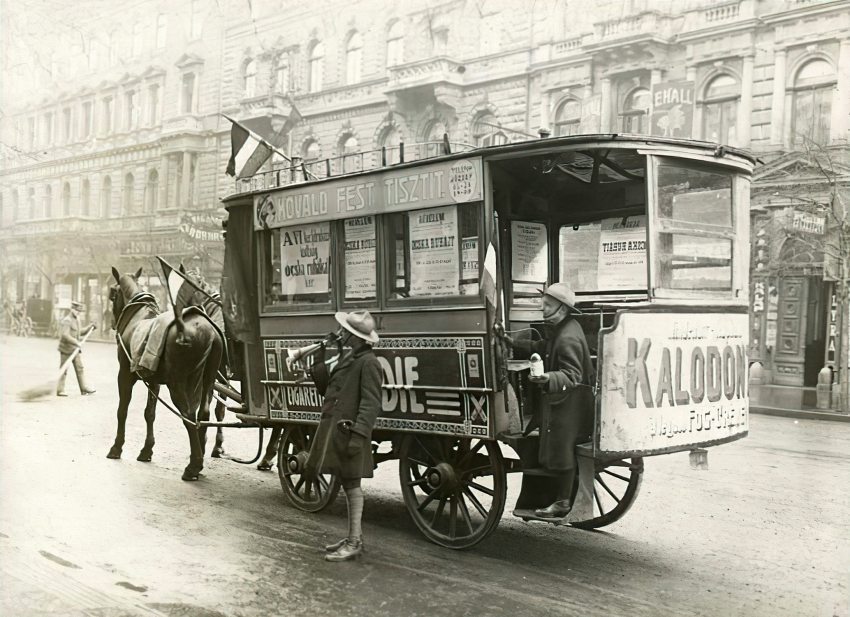
One carriage for all
The first carriage company was the idea of the mathematician-philosopher Blaise Pascal in 1662. The service was first used by Louis XIV, the Sun King, so it's no surprise that it became popular with the nobility. The business lasted only fifteen years, and for the next century and a half mail coaches were used for long-distance passenger transport. From the 19th century onwards, the railways became the new alternative to overcome the distance, but as cities grew, the demand for shorter-distance means of transport that were accessible to the masses increased. In 1826, an entrepreneur from Nantes offered a solution by launching a carriage service between the city center and the suburban spa. The service, which became one of the cornerstones of urban public transport, became known as ‘voiture omnibus’, or carriage for all.
To the City Park for a few coins
The omnibus service in Pest started on 1 July 1832. The entrepreneur János Kratochwill had local guildmasters make covered carriages that ran between his two cafés, today's Széchenyi István Square and the City Park, covering the three-kilometre distance in about twenty to twenty-five minutes. The service opened up a new era in the life of the city, for until then most people walked, only the wealthier could afford to travel in a hired coach, a Hansom cab, or a two-horse drawn carriage.
The omnibuses, which ran every hour and then every half hour between six in the morning and six in the evening, had no stops, they stopped wherever passengers wanted to get off.
Other sources claim that Kratochwill's omnibus was not the first: "The late Ödön Lechner, the brilliant architect, told us that his grandfather [...] tried out the first omnibus in Pest in the late twenties", which "nobody wanted to ride. Finally, the old man got angry and one Sunday he put his wife and children on the unusual means of transport and drove out to the City Park. However, the journey was not such a good idea after all because "the folks" were surprised by the strange constitution, the children ran after Lechner's carriage and shouted all sorts of obscene things after Lechner" - reads the 1929 issue of the Magyar Hírlap ('Hungarian Newspaper') magazine.
Tickets for the eight to fourteen-seater omnibus cost between six and ten krajcár depending on the distance. Since the daily wage of a maid was twenty to thirty krajcár, it was mainly retailers, clerks, craftsmen, and intellectuals who could take advantage of the new public transport. Despite this, the omnibus, also known as the all-rounder, or the buddy-car, became so popular that a month later the first omnibus was launched on the other side of the Danube, in Buda, too, running from Tabán via Víziváros to Lipótmező.
Fashionable like the omnibus
"Twenty years ago there were hardly any omnibuses in Pest. The tenant of the Veli Bej Bath, József Szekrényessy, used to have a few large and heavy carriages built. A couple went to the Veli Bej Bath, four or five (mostly empty) to the City Park, and then a few to the developing New Pest. In the fifties, most of the population was still shy of such cheap rides. But at the end of the decade, the number of carriages increased, and the middle classes started to use them. And at the beginning of this decade, especially after Ferenc Deák and his companions used to take the omnibus to the City Park, it became quite fashionable. Since then, one can often see in them even such distinguished people who otherwise also have magnificent own carriages with coats of arms" – wrote the January 1869 issue of the Fővárosi Lapok (Capital City Newspaper).
With the popularity of omnibuses, the crowds on the buses also increased, with the 1845 issue of the Honderű ('Country Fun') magazine saying that they look "like a cage in which poultry are crammed to bursting point".
The carriages soon appeared in the countryside, in 1847 they were already in Sopron, and ten years later they were on the streets of Szeged, Miskolc, Debrecen, Szombathely, and Székesfehérvár, mainly transporting passengers between the city center and the railway station.
The competition: the horse-drawn railway
In 1866, omnibus traffic declined overnight: the horse-drawn railway was introduced. At first, it was used in the mines, as previously the corves were moved on wooden tracks by men. From the second half of the 18th century, wood was replaced by iron structures, and horses were used to pull the carriages, making it more efficient to move heavier objects.
The first scheduled horse-drawn passenger railways started in 1803 in South London, and the first line in Hungary was established in 1827 between Pest and Kőbánya, but the service only ran for a year. Nevertheless, a nationwide network was planned, and between 1840 and 1846, horse-drawn railways were reintroduced between Pozsony (Bratislava) and Nagyszombat (Trnava) and then Szered (Sered), but in the long term neither the speed nor the capacity could compete with steam.
However, steam-powered railways were not a success in the cities, so in 1860 the first Hungarian horse-drawn railway was launched in Lippa. In Pest, it appeared six years later, running for the first time between the city center (Kálvin Square) and North Pest (Újpest-Városkapu), and two years later it was available on the Buda side between the Chain Bridge and Zugliget, and between the Chain Bridge and the Main Square in Óbuda. The appearance of the electric trams of 1887 put an end to the days of the horse-drawn railways, with the last service to Margaret Island ending in 1928.
The last night
In 1884, the capital city issued a decree standardizing the conditions for omnibus travel. Among other things, it stipulated that coaches should be up to seven and a half meters long and two and a half meters wide, must be fitted with signal lamps, and that the interior, which could accommodate ten passengers, could be lit by candles. The turn of the century saw the introduction of double-decker buses with a narrow iron staircase leading to the top. These coaches were the inspiration for the well-known operetta hit "Night on the Roof of the Omnibus", which made its debut in 1926 in a performance of the operetta by Béla Zerkovitz.
While in 1832 there were five omnibuses carrying around 200,000 passengers a year, by 1912 there were one hundred and sixty-one horse-drawn carriages for 13.4 million passengers.
These carriages were gradually replaced by the buses introduced in the 1890s, which began regular service in Budapest in March 1915. The last omnibus passed through Villányi Road on 5 November 1929, and one of the journalists of the Magyar Hírlap magazine ('Hungarian Newspaper') wrote of the event. "I can not smile at the downfall of poor omnibuses. With their disappearance a little piece of old Pest disappeared too, and with the old, rattling, rumbling carriages and the jogging horses a piece of the city's charm moved out of the city."
